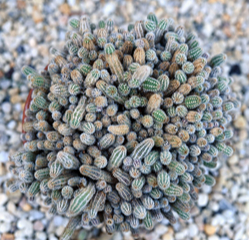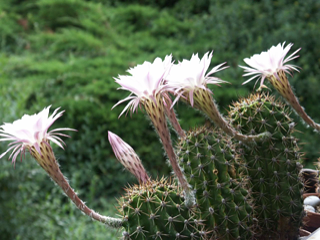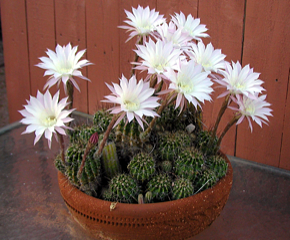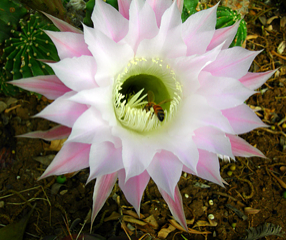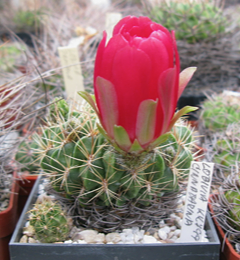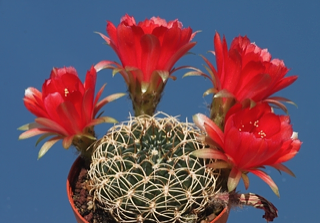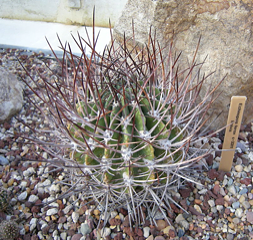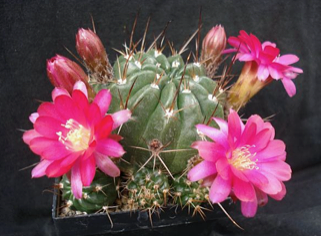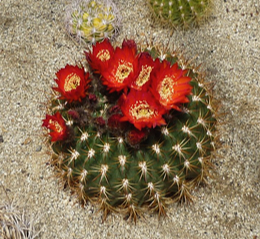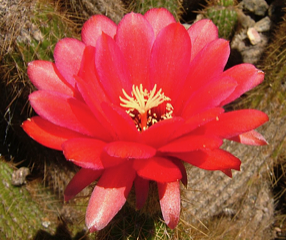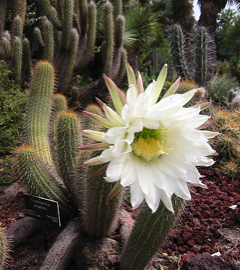Submitted by: Jim Tanner and Terri Straub
The naming of cacti in these four genera can be very confusing to say the least! There used to be over 100 different species included in the genus Echinopsis. Studies in the 1970s and 1980s resulted in several formerly separate genera being absorbed into Echinopsis. Some genera were absorbed into Echinopsis and then accepted as a separate genus again. In October of 2023, the following genera were separated out of Echinopsis: Soehrensia, Lobivia, Chamaecereus, and others.
There is a tremendous amount of variation among the different species. The plants range from very small, flattened-globose plants to quite large, treelike giants. The main factor that ties these plants together are their very large, showy flowers. These flowers are all very similar in structure – funnel shaped, with hairy/wooly scaled floral tubes which give rise to hairy, globular fruit filled with a soft, mushy pulp. The flowers seldom last more than a single day and may be diurnal or nocturnal depending on the species. These species hybridize easily and have resulted in a tremendous number of hybrids that some cactus growers specialize in or grow exclusively. Because of their exceptional flowers, many of these species are found in garden centers and collections world-wide.
These four genera are all native to South America. They thrive in desert grasslands, shrub-land, and in situations where the soil is sandy or gravelly, such as the sides of hills in the crevices of rocks. They will thrive in cultivation if potted in light loam, with a little leaf mold and a few nodules of limestone. The limestone keeps the soil open; it is important that the soil be well drained.
Echinopsis cacti are native to Argentina, Bolivia, Brazil, Peru, Uruguay, and Paraguay. They are sometimes known as hedgehog cactus, sea-urchin cactus or Easter lily cactus. As of October 2023, there are now only about 20 accepted species of Echinopsis. The name derives from ‘echinos’ hedgehog or sea urchin, and ‘opsis’ appearance, a reference to these plants’ dense coverings of spines.
Soehrensia cacti are native to northern Argentina, Bolivia, northern Chile, Paraguay, and Peru. There are about 24 different species in this genus.
The genus was established by Curt Backeberg in 1938. The genus name of Soehrensia is in honor of Johannes Soehrens (died 1934), who was a Dutch botanist and Professor and Director of the Botanical Garden in Santiago de Chile. He was an authority on cacti.
Lobivia cacti are native to Bolivia, Peru to northwestern Argentina, and northern Chile. There are about 30 different species in this genus. Lobivia is an anagram of Bolivia.
Chamaecereus cacti are native to Argentina and Bolivia. There are currently 5 different species in this genus. Chamaecereus, pronounced kam-ay-KER-ee-us or kam-ay-SER-ee-us is from the Greek chamai (ground) and cereus (wax candle, torch).,
By Terri Straub.
LATIN LOOKUP – Loquerisne Latine (Do you speak Latin)?
The meanings of latin plant names on this page – from https://davesgarden.com/guides/botanary/
- bruchii [BROO-kee-eye]
Named for Dr. Carlos Bruch, 20th century cactus collector in Argentina. - chamaecereus [kam-ay-KER-ee-us, kam-ay-SER-ee-us]
From the Greek chamai (ground) and cereus (wax candle, torch). - cinnabarina [sin-uh-bar-EE-nuh, kin-uh-bar-EE-nuh]
Cinnabar-red. - Echinopsis [ek-in-OP-sis]
From the Greek echinos (sea urchin or hedgehog) and opsis (like), referring to the plant’s resemblance to sea urchins. - ferox [FER-oks]
Fierce. - huascha [WAS-kuh]
A local vernacular name in Argentina that means ‘orphan’. - Lobivia [low-BIV-ee-uh]
Anagram of Bolivia, where the plant is native. - oxygona [ok-SY-goh-nuh]
Sharp-angled. - silvestrii [sil-VEST-ree-eye]
Named for Filippo Silvestri, 19th century Italian entomologist and zoologist; also spelled sylvestrii. - spachiana [spak-ee-AY-nuh]
Named for Edouard Spach,19th century Alsatian (French) botanist.
